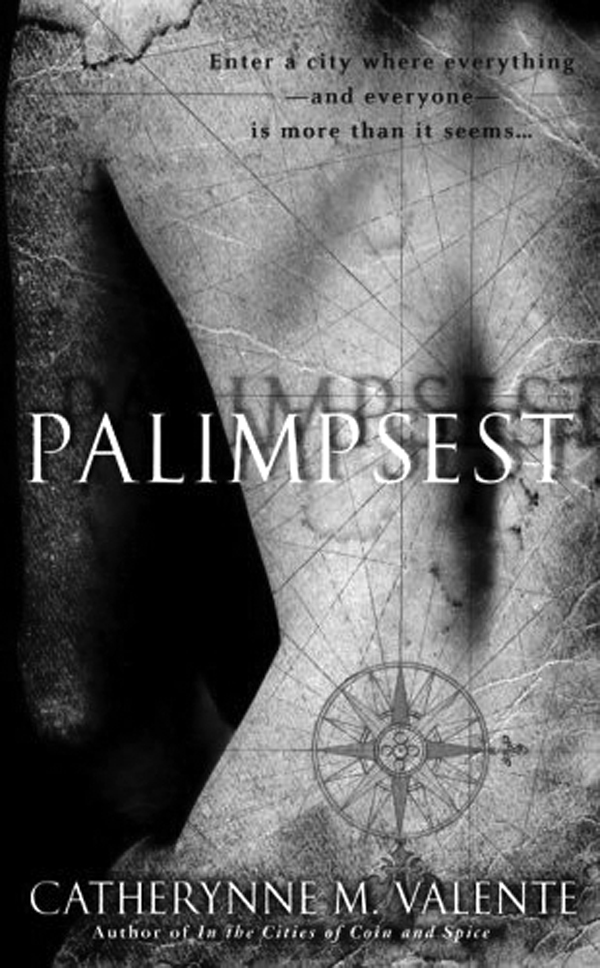(Bantam Spectra, 2009)
Reviewed by Debbie Block-Schwenk
“From every terrace and corner grin gargoyles through which old rainwater spurts in sprays and splashes, only to be caught in long pools at the base of each tower. The little faces are mice and hedgehogs and opossums, foxes and rats and blind, nosing moles. Their faces contort as all gargoyles do, peering from within curling stone leaves, licking sharp teeth, but their faces seem so sweet and dear to her, she laughs in the middle of the street, and they grin wider on their heights.”
(pg. 130)
The author, Catherynne Valente, is a poet and a folklorist (as well as a novelist). Both aspects of her background are obvious in this gorgeous and intense fantasy novel about four strangers, the urge to belong, and a magical city called Palimpsest.
A palimpsest is “a manuscript, typically of papyrus or parchment, that has been written on more than once, with the earlier writing incompletely erased and often legible” (dictionary.com). While Palimpsest is the name of the city, all of the major characters in the novel become palimpsests as well – their prior identities partially erased and written over – metaphorically and literally – by the touch of those who have visited the city and who transmit the influence of the city to anyone with whom they are sexual.
Visiting Palimpsest marks the “immigrant” with a tattoo – a black map of a portion of the city magically inked into their skin: While these visits happen in dreams, Palimpsest is not a dream. The city of Palimpsest is just as seductive – and dangerous – as these ancient stories of Faerie which Valente taps into. The trap – and the temptation – is that you can only visit the part of the city on your lover’s body. To see more, to go further, you must find a new partner.
“Together they auditioned men and women, lifting sleeves and hats and skirts to peer at maps so tiny they made Sei’s head throb. Yumiko seemed to know what she was looking for, but all the same it was not until two in the morning that she found a nervous, skinny man with scarred cheeks and a scraggly mustache whose hip was scrawled over with a dense map…”
(pg. 106)
The novel’s four protagonists are Sei, a Japanese railway worker who longs for the trains of Palimpsest; November, a woman who keeps bees in California; Oleg, a locksmith haunted by the sister who died before his birth; and Ludovico, an Italian bookbinder whose wife has left him. Arriving in Palimpsest at the same time, they are bound together, feeling echoes of each others’ experiences and gradually reaching out to each other in our world as well.
But there are dangers, both in the toll that living torn between two worlds takes on the characters, and in Palimpsest itself. A war in Palimpsest has scarred the inhabitants of the city, especially the soldiers of the losing side whose bodies were mutilated – their legs or heads replaced with those of animals in order to increase their speed or ferocity. And just like in old fairy tales before modern sensibilities softened them, sometimes sacrifices – brutal and painful, but cathartic – are required. “This is the real world,” Palimpsest’s matriarch, Casimira, tells November, “Nothing comes without pain and death.” (pg 209).
Bisexuality plays a huge part in this novel. All the characters toss aside any consideration of gender in their obsession to find someone marked with a map of Palimpsest to sleep with. But three of the main characters were bisexual before their first visit, and they connect with same-sex partners (for varying periods of time) as they learn about the new world that awaits them in dreams:
“She kissed her then, and the Golden Pavilion glowed dully behind them. Yumiko slid her hand under Sei’s skirt and pressed her fingers against her urgently, furtively. – there was no one around them, but the sun was frosty and white on them, and they were so bare. Sei opened her legs to allow the girl’s hand inside her and shut her eyes against the warm air, the red leaves, the silver temple. She could not draw breath for the taste of sassafras and run in Yumiko’s mouth….”
(pg. 44)
November also finds a connection in Palimpsest, through their shared love of bees, with Casimira, whose bees and bugs and vermin provide her with eyes and ears throughout the city. These two women were the strongest characters in the book, and the others’ journeys were catalyzed by this relationship. Even this connection, though, is tinged with a brutality that might offend some readers.
If you like your fairy tales with a thread of darkness; if you are willing to imagine that sometimes our bodies are just portals to other worlds; if you allow the lush flow of the prose to seduce you, even if that seduction has a bite, then Palimpsest will provide you with a multitude of pleasures.
Debbie is a long-time Bi Women contributor whose first stop in the bookstore is always the sci-fi/fantasy section.

